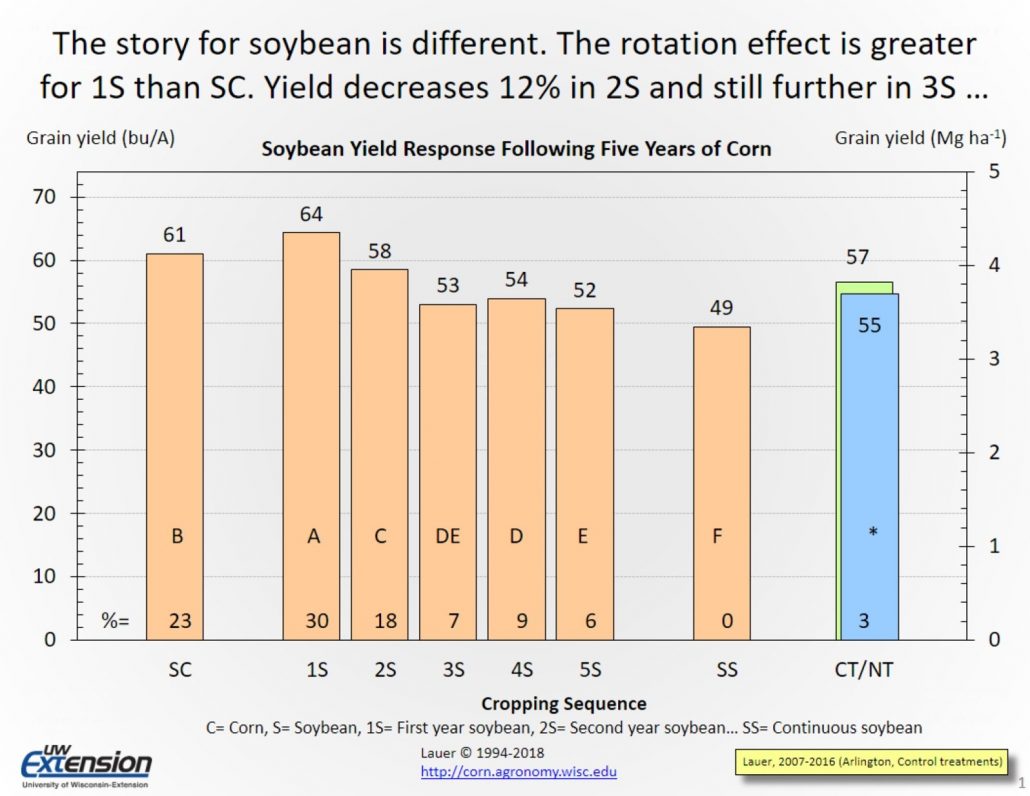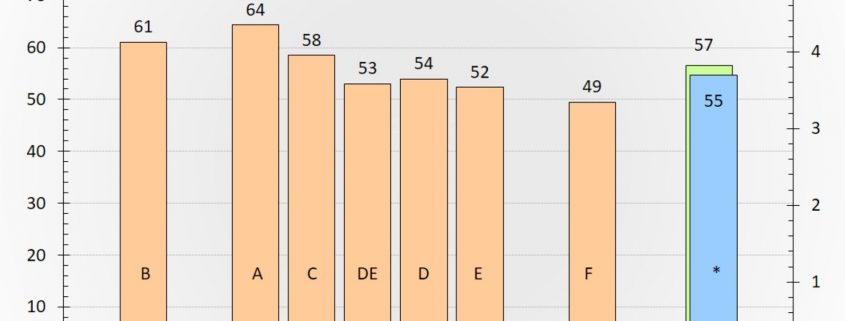Best Management Practices for Growing Second or Third Year Soybean
Originally Coauthored by: Shawn P. Conley, Seth Naeve and John Gaska December 14, 2016. Modified by S.P.Conley 1/22/18.
Modified by S. P. Conley, E. G. Matcham, and L. C. Malone 12/15/2021.
Before we start, we fully acknowledge our title “Best management practices for growing second or third year soybean” is a bit misleading as we do not advocate this practice (it’s not a BMP!) but we thought we could sucker you into reading this article if it had an enticing title!
This article was originally updated in 2018 when the USDA announced that U.S. soybean acres in 2018 will surpass U.S. corn acres. These acres have to come from somewhere and many of them will be from second-year soybean.With input costs rising rapidly, especially for nitrogen fertilizers, we thought it was time for another update. Many of our management recommendations remain the same, but we also have some additional recommendations based on recent crop rotation and nutrient management research.
With that being said, here are some recommendations to consider:
- Balancing short-term versus long-term profitability (i.e., economic sustainability). Every year promises of short-term profitability may drive some farmers to consider planting soybean after soybean, rather than rotating, data from our long -term rotation experiment clearly shows the benefit of crop rotation to the soybean crop. It is amazing that after 5 years of corn, it only took 3 years of continuous soybean for the yield to drop to within 7% of continuous soybean (20+ years) yield levels whereas 2nd year soybean yielded within 5% of soybean in a corn-soybean rotation. We could hypothesize then that the yield of the 3rd year of continuous soybean (in our experiment) would be like a 2nd year of soybean in a corn soybean (C-S-S) rotation. Our data clearly shows that 3 or more years of continuous soybean gives you a 7+ bu per acre hit when compared to a corn-soybean rotation and moves you close to the yield levels of continuous soybean. In short, you are setting your long-term profitability up for a hit. Another long-term rotation study we have (19 years) shows an even bigger yield benefit (13%) to rotating away from soybean for two years (corn and wheat) compared to annually rotating corn and soy.

- Be aware that soybean after soybean will alter the pest relationship complex in your fields. Some of these alterations may take years to undo as you will be making a long-term impact on your soil and resulting soil health. We looked at soil fungi in our long-term rotation study and found increased Fusarium (which causes damping off in soybean) in continuous soybean plots. On the “good microbes” side of things, soybean isn’t a great host of AMF, a fungus that helps take up water and phosphorus, and rotating away from better hosts like corn for more than a year can decrease AMF populations in your field that other crops might benefit from. Read more about this soil fungi data here.
- Also don’t automatically think that simply adding a cover crop to this S-S rotation will “fix” these issues. In an Ohio study, rye cover crops only increased yields by 2-6 bu/acre and did not impact disease or insect pressure compared to control plots without cover crops.
- Plant a different variety than was planted in that field the previous year and make sure it has strong disease resistance traits to the problems you have in that field! Every variety has a weakness and planting the same variety on the same land 2 years in a row will expose that weakness. Note that these varieties must be truly different. The same bean in a different color bag will greatly increase your risk of disease losses. Please see our 2021Wisconsin Soybean Variety Performance Trials for information.
- Test for SCN and select SCN resistant varieties. SCN proliferates in long-term soybean cropping systems. Control weeds that are alternate hosts for SCN like field pennycress, shepherd’s-purse, and chickweed and do not plant leguminous cover crops that can be an alternative host for SCN. Be prepared to scout your fields more intensively to get ahead of any disease problems. Increased disease pressure is likely to be more pronounced in no-till fields and may provide an opportunity to see yield responses from fungicides and insecticides. Include the cost of additional crop protection applications in your economic estimates for short-term profitability.
- Keep seeding rates lower if white mold was a problem in the field
- Use a seed treatment at the max a.i. fungicide rate.
- Use a pre-emergence herbicide and use multiple modes of action. If you had weed escapes, expect even larger problems in soybean after soybean.
- Soil sample and replace K if needed: An 80-bushel soybean crop meant you removed ~98 pounds per acre of K20 equivalent fertilizer. Growers often routinely rely on carryover fertilizers for soybean when rotated with well-fertilized corn. Soybean after soybean may require additional fertilizer, especially K.
Back on the soil microbe note, we looked at the soil bacterial communities under corn-soybean rotation (5 years of corn followed by 5 years of soybean). These communities are affected by a lot of factors, like pH, moisture, and nutrients, along with the plants growing there. The figure below shows ordinations of bacterial communities – each point on the graph is a plot in our field experiment, and the further apart points are, the more different those communities are. This figure focuses on soybean phases. The main point here is that the first and second year of soybean after 5 years of corn are pretty similar to each other, while the 3rd, 4th, and 5th year of soybean start to look more like the continuous soybean (30+ years). This trend might remind you of the yield trends discussed earlier in this post! Bulk soil microbial communities are complicated, and they take a long time to change…sticking with soybean for one extra year may not shift the community drastically, but 3+ years is more likely to. The data from this study isn’t published yet, but if you are curious about bacterial communities and corn/soybean rotation in the soil you can read more here.

Additional recommendations for years 3+:
- Even if you only saw an increase in disease pressure without an increase in insect pressure in year 2 beans, expect to see an increase in both diseases and insects in year 3+. Budget accordingly for crop protection products.
- Consider increasing your seeding rate in fields with high pressure for seedling diseases such as pythium or phytophthora. Don’t increase your seeding rate in fields with high white mold pressure.
- Soybean removes more K and S per acre than corn. Consider increasing soil sampling frequency to monitor K levels, and scout fields regularly for S and micronutrient deficiencies.




